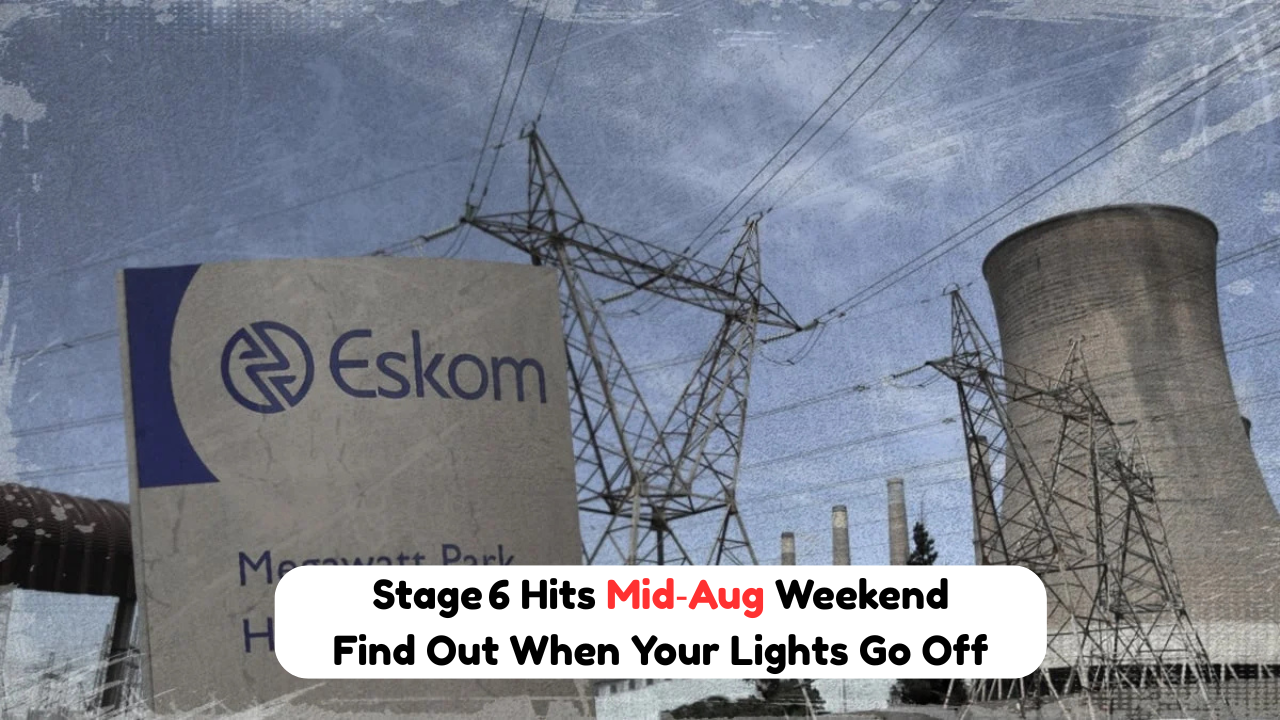
South Africans are preparing for another weekend of severe electricity disruptions as Eskom officially declares a Stage 6 power crisis for the coming days. With load shedding ramped up to one of its highest levels, millions across all nine provinces face frequent and extended blackouts. Eskom has released detailed schedules for outage zones, urging residents and businesses to check their specific times and plan accordingly.
The escalation to Stage 6 is the result of ongoing technical breakdowns, delayed maintenance, and a continued strain on Eskom’s generating capacity. This crisis not only affects households and businesses but also places additional pressure on schools, healthcare facilities, and critical infrastructure across the nation.
What Does Stage 6 Load Shedding Mean for South Africans?
Stage 6 load shedding means Eskom must remove up to 6,000 megawatts from the national grid at various times throughout the day. For ordinary South Africans, this translates to:
- Up to four scheduled power outages per day, depending on your area.
- Outages lasting between two and two-and-a-half hours at a time.
- Rolling blackouts affecting homes, businesses, hospitals, schools, and municipal services.
- Increased likelihood of unscheduled outages if the grid faces unexpected failures.
Residents are urged to monitor official communication channels and local municipality websites or apps for the latest updates, as real-time changes can occur.
Scheduled Outage Zones by Province: Key Timetables for Stage 6
Eskom and major municipalities have published the following example schedules for the Stage 6 weekend. Actual times may vary, so always confirm with your local provider or EskomSePush app.
| Province | Example Friday | Example Saturday | Example Sunday | Notes |
|---|---|---|---|---|
| Gauteng | 04:00–06:30, 12:00–14:30, 20:00–22:30 | 02:00–04:30, 10:00–12:30, 18:00–20:30 | 06:00–08:30, 14:00–16:30, 22:00–00:30 | Includes Johannesburg, Pretoria, Ekurhuleni |
| Western Cape | 06:00–08:30, 14:00–16:30, 22:00–00:30 | 04:00–06:30, 12:00–14:30, 20:00–22:30 | 08:00–10:30, 16:00–18:30, 00:00–02:30 | Cape Town, rural and coastal towns |
| KwaZulu-Natal | 02:00–04:30, 10:00–12:30, 18:00–20:30 | 06:00–08:30, 14:00–16:30, 22:00–00:30 | 04:00–06:30, 12:00–14:30, 20:00–22:30 | Durban (eThekwini), Pietermaritzburg, etc. |
| Eastern Cape | 04:00–06:30, 12:00–14:30, 20:00–22:30 | 06:00–08:30, 14:00–16:30, 22:00–00:30 | 02:00–04:30, 10:00–12:30, 18:00–20:30 | Gqeberha, East London, smaller towns |
| Free State | 08:00–10:30, 16:00–18:30, 00:00–02:30 | 04:00–06:30, 12:00–14:30, 20:00–22:30 | 06:00–08:30, 14:00–16:30, 22:00–00:30 | Bloemfontein, Welkom, rural areas |
| Limpopo | 06:00–08:30, 14:00–16:30, 22:00–00:30 | 08:00–10:30, 16:00–18:30, 00:00–02:30 | 04:00–06:30, 12:00–14:30, 20:00–22:30 | Polokwane, Tzaneen, rural municipalities |
| Mpumalanga | 04:00–06:30, 12:00–14:30, 20:00–22:30 | 06:00–08:30, 14:00–16:30, 22:00–00:30 | 08:00–10:30, 16:00–18:30, 00:00–02:30 | Nelspruit, Witbank, Middelburg |
| North West | 08:00–10:30, 16:00–18:30, 00:00–02:30 | 02:00–04:30, 10:00–12:30, 18:00–20:30 | 06:00–08:30, 14:00–16:30, 22:00–00:30 | Rustenburg, Mahikeng, smaller towns |
| Northern Cape | 06:00–08:30, 14:00–16:30, 22:00–00:30 | 04:00–06:30, 12:00–14:30, 20:00–22:30 | 08:00–10:30, 16:00–18:30, 00:00–02:30 | Kimberley, Upington, rural areas |
Always consult your local municipality or EskomSePush app for the most accurate, up-to-date schedule.
How to Find Your Exact Blackout Times
To avoid confusion and prepare for outages:
- Use the EskomSePush app for real-time, area-specific notifications.
- Check your municipality’s website for local schedules.
- Sign up for SMS or WhatsApp alerts, where available.
- Monitor community groups and neighborhood forums for urgent updates.
- Contact your ward councillor for local contingency planning.
Being informed in advance allows you to safeguard appliances, manage household routines, and reduce stress during outages.
Why Is Stage 6 Necessary? Understanding the Crisis
The move to Stage 6 is due to:
- Unplanned breakdowns at key coal-fired power stations.
- Delays in returning units to service after overdue maintenance.
- Lower renewable energy output, especially during winter.
- Ongoing diesel shortages for backup generators.
- Sustained high demand across all provinces.
Eskom assures the public that technical teams are working 24/7 to restore capacity, but the grid remains under extreme pressure.
Impact of the Stage 6 Power Crisis
Stage 6 brings major challenges to all sectors:
- Households: Extended daily blackouts disrupt cooking, heating, and family routines.
- Businesses: Retailers, manufacturers, and offices face lost productivity and added costs for backup power.
- Schools and Hospitals: Teaching, exams, and critical care may be affected without reliable backup.
- Essential Services: Water supply, public transport, and security systems may experience interruptions.
- Food Security: Prolonged outages increase risks for perishable goods.
Communities are urged to support vulnerable members and report infrastructure faults promptly.
Essential Tips to Manage the Stage 6 Blackouts
- Charge phones, laptops, and backup batteries before outages begin.
- Switch off and unplug appliances before load shedding to prevent surge damage.
- Prepare meals ahead of time and keep non-perishable food on hand.
- Store water in case of supply interruptions linked to power outages.
- Use battery-powered lights instead of candles to avoid fire risk.
- Check on elderly and vulnerable neighbors during and after blackouts.
- Plan your work and study schedules around known blackout slots.
Preparation and community communication can help mitigate the worst effects of the crisis.
Quick Comparison: Stages 4, 5, and 6 Load Shedding
| Stage | Daily Outages per Area | Duration per Outage | Total Daily Blackout (approx.) | National Impact |
|---|---|---|---|---|
| 4 | 2–3 | 2 hours | 4–6 hours | Severe |
| 5 | 3–4 | 2–2.5 hours | 6–8 hours | Very severe |
| 6 | 4+ | 2–2.5 hours | 8–10 hours | Most severe |
Each escalation adds more hours of blackout and greater pressure on daily life and the economy.
South Africa’s entry into Stage 6 power crisis this weekend is a stark reminder of ongoing challenges in the national energy sector. Eskom’s detailed outage schedules give residents and businesses a chance to plan ahead, but the entire nation must prepare for extended blackouts. Staying informed, adopting safe habits, and supporting one another remain the best strategies until stability is restored.
Frequently Asked Questions (FAQs)
Q1: What is Stage 6 load shedding?
A: Eskom removes up to 6,000 megawatts from the grid, leading to 4 or more blackouts per day in most areas.
Q2: Where can I check my exact outage schedule?
A: Use the EskomSePush app, your municipality’s website, or local community alerts for the most current schedules.
Q3: Can outage times change on short notice?
A: Yes, outages may shift due to grid conditions. Always double-check before each blackout slot.
Q4: How long will Stage 6 last?
A: Duration depends on Eskom’s ability to restore capacity, but expect several days at minimum.
Q5: Do critical services have backup power?
A: Many hospitals and key services have generators, but some interruptions are still possible.
Q6: How can I protect my appliances during load shedding?
A: Unplug appliances before outages and only switch them back on after power is stable.
Q7: Will businesses and schools stay open?
A: Most will remain open but may reduce hours or switch to backup power during outages.
Q8: Where can I report faults or emergencies?
A: Contact your municipality or Eskom’s faults line for urgent issues beyond scheduled outages.





